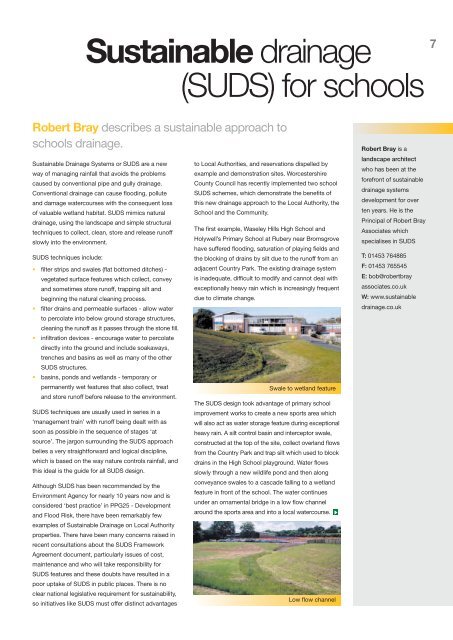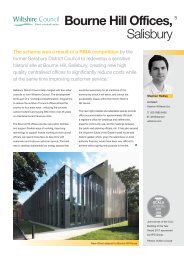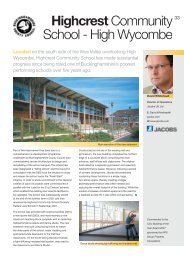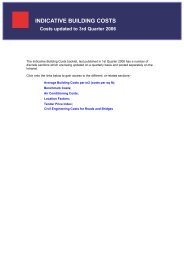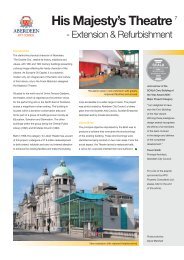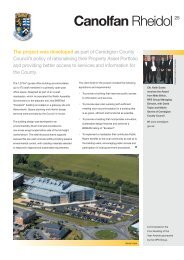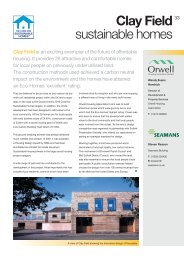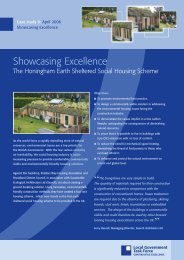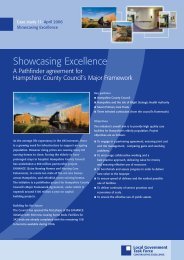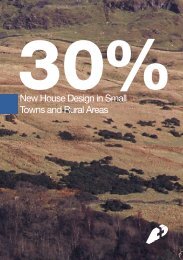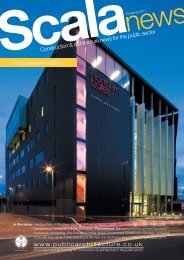sustainable drainage for schools.pdf - Public Architecture
sustainable drainage for schools.pdf - Public Architecture
sustainable drainage for schools.pdf - Public Architecture
You also want an ePaper? Increase the reach of your titles
YUMPU automatically turns print PDFs into web optimized ePapers that Google loves.
Sustainable <strong>drainage</strong><br />
(SUDS) <strong>for</strong> <strong>schools</strong><br />
7<br />
Robert Bray describes a <strong>sustainable</strong> approach to<br />
<strong>schools</strong> <strong>drainage</strong>.<br />
Sustainable Drainage Systems or SUDS are a new<br />
way of managing rainfall that avoids the problems<br />
caused by conventional pipe and gully <strong>drainage</strong>.<br />
Conventional <strong>drainage</strong> can cause flooding, pollute<br />
and damage watercourses with the consequent loss<br />
of valuable wetland habitat. SUDS mimics natural<br />
<strong>drainage</strong>, using the landscape and simple structural<br />
techniques to collect, clean, store and release runoff<br />
slowly into the environment.<br />
SUDS techniques include:<br />
• filter strips and swales (flat bottomed ditches) -<br />
vegetated surface features which collect, convey<br />
and sometimes store runoff, trapping silt and<br />
beginning the natural cleaning process.<br />
• filter drains and permeable surfaces - allow water<br />
to percolate into below ground storage structures,<br />
cleaning the runoff as it passes through the stone fill.<br />
• infiltration devices - encourage water to percolate<br />
directly into the ground and include soakaways,<br />
trenches and basins as well as many of the other<br />
SUDS structures.<br />
• basins, ponds and wetlands - temporary or<br />
permanently wet features that also collect, treat<br />
and store runoff be<strong>for</strong>e release to the environment.<br />
SUDS techniques are usually used in series in a<br />
‘management train’ with runoff being dealt with as<br />
soon as possible in the sequence of stages ‘at<br />
source’. The jargon surrounding the SUDS approach<br />
belies a very straight<strong>for</strong>ward and logical discipline,<br />
which is based on the way nature controls rainfall, and<br />
this ideal is the guide <strong>for</strong> all SUDS design.<br />
Although SUDS has been recommended by the<br />
Environment Agency <strong>for</strong> nearly 10 years now and is<br />
considered ‘best practice’ in PPG25 - Development<br />
and Flood Risk, there have been remarkably few<br />
examples of Sustainable Drainage on Local Authority<br />
properties. There have been many concerns raised in<br />
recent consultations about the SUDS Framework<br />
Agreement document, particularly issues of cost,<br />
maintenance and who will take responsibility <strong>for</strong><br />
SUDS features and these doubts have resulted in a<br />
poor uptake of SUDS in public places. There is no<br />
clear national legislative requirement <strong>for</strong> sustainability,<br />
so initiatives like SUDS must offer distinct advantages<br />
to Local Authorities, and reservations dispelled by<br />
example and demonstration sites. Worcestershire<br />
County Council has recently implemented two school<br />
SUDS schemes, which demonstrate the benefits of<br />
this new <strong>drainage</strong> approach to the Local Authority, the<br />
School and the Community.<br />
The first example, Waseley Hills High School and<br />
Holywell’s Primary School at Rubery near Bromsgrove<br />
have suffered flooding, saturation of playing fields and<br />
the blocking of drains by silt due to the runoff from an<br />
adjacent Country Park. The existing <strong>drainage</strong> system<br />
is inadequate, difficult to modify and cannot deal with<br />
exceptionally heavy rain which is increasingly frequent<br />
due to climate change.<br />
Swale to wetland feature<br />
The SUDS design took advantage of primary school<br />
improvement works to create a new sports area which<br />
will also act as water storage feature during exceptional<br />
heavy rain. A silt control basin and interceptor swale,<br />
constructed at the top of the site, collect overland flows<br />
from the Country Park and trap silt which used to block<br />
drains in the High School playground. Water flows<br />
slowly through a new wildlife pond and then along<br />
conveyance swales to a cascade falling to a wetland<br />
feature in front of the school. The water continues<br />
under an ornamental bridge in a low flow channel<br />
around the sports area and into a local watercourse.<br />
Low flow channel<br />
Robert Bray is a<br />
landscape architect<br />
who has been at the<br />
<strong>for</strong>efront of <strong>sustainable</strong><br />
<strong>drainage</strong> systems<br />
development <strong>for</strong> over<br />
ten years. He is the<br />
Principal of Robert Bray<br />
Associates which<br />
specialises in SUDS<br />
T: 01453 764885<br />
F: 01453 765545<br />
E: bob@robertbray<br />
associates.co.uk<br />
W: www.<strong>sustainable</strong><br />
<strong>drainage</strong>.co.uk
8 Sustainable <strong>drainage</strong> (SUDS) <strong>for</strong> <strong>schools</strong><br />
The SUDS system provides a number of benefits:<br />
“The capital costs<br />
<strong>for</strong> the project were<br />
reasonable and<br />
provided incidental<br />
benefits not usually<br />
associated with<br />
<strong>drainage</strong>.”<br />
• SUDS creates a new robust natural <strong>drainage</strong> system.<br />
• SUDS controls overland flows and retrieves playing<br />
fields <strong>for</strong> the <strong>schools</strong>.<br />
• SUDS traps silt and controls pollution.<br />
• SUDS protect the <strong>schools</strong> and adjacent properties<br />
from flooding.<br />
• SUDS provides a visual, educational and<br />
wildlife resource.<br />
The capital costs <strong>for</strong> the project were reasonable and<br />
provided incidental benefits not usually associated<br />
with <strong>drainage</strong>. There is also an opportunity to reduce<br />
charges by the Water Company as all the runoff from<br />
the Primary School now flows to the watercourse<br />
without entering the storm sewer.<br />
Maintenance of the SUDS features will be done by<br />
existing landscape contractors who are familiar with<br />
the basic requirements of litter collection, grass cutting,<br />
inlet-outlet inspections and wetland management.<br />
This should be cheaper than cleaning gullies and<br />
pipes, as it is part of everyday site care, and is visible<br />
<strong>for</strong> inspection and enjoyment by the school.<br />
The second SUDS scheme is <strong>for</strong> a new primary school<br />
at Matchborough in Redditch. This new project was<br />
underway when problems with the conventional<br />
<strong>drainage</strong> design became apparent. Water was to be<br />
collected in gullies and pipes into a pumping station<br />
and then pumped up to the storm sewer. This would<br />
have resulted in a £3000 p.a. service charge to the<br />
Water Company and an annual maintenance bill <strong>for</strong><br />
the pumping station of £800. This scheme was<br />
expensive and could not accommodate runoff from<br />
the school playground, as this is located behind the<br />
school at the lowest part of the development.<br />
A SUDS scheme collects runoff in attractive wetland<br />
basins at the front of the school draining both the<br />
main drive and the car parks. Water flows through a<br />
long swale following the western boundary hedge,<br />
picking up roof runoff where it is surplus to the<br />
requirements of a rain harvesting system and leading<br />
to a storage wetland. Playground runoff is collected in<br />
a swale which travels between the playground and the<br />
playing field also flowing to the wetland. Runoff from<br />
existing adjacent housing is intercepted in another<br />
boundary swale which discharges directly to the Ipsley<br />
Brook, again protecting playing fields from winter<br />
saturation caused by sheet water flow across the site.<br />
Collector basin <strong>for</strong> school entrance<br />
The Head Teacher at Matchborough is eager to<br />
integrate the SUDS scheme with the ‘Forest Schools’<br />
approach to primary education being pioneered by<br />
Worcestershire County Council, and incorporate<br />
curriculum studies with the wetland resource. Careful<br />
SUDS design and a measured consideration of Health<br />
and Safety are allowing children to experience water<br />
in a controlled way.<br />
The SUDS approach to <strong>drainage</strong> delivers a holistic<br />
and cost effective solution to the management of<br />
rainfall on school sites which can be easily managed<br />
using current landscape maintenance practices.<br />
Storage wetland<br />
SUDS schemes are simple, robust and easily<br />
understood by all school stakeholders with<br />
opportunities <strong>for</strong> educational and wildlife benefits.<br />
Capital and management costs <strong>for</strong> SUDS are usually<br />
less than conventional <strong>drainage</strong> and where water can<br />
infiltrate or flow to watercourses then <strong>schools</strong> can avoid<br />
connection fees and annual storm sewer charges.<br />
The benefits of SUDS to the school campus<br />
situation are now being understood at Waseley<br />
and Matchborough with more exciting SUDS<br />
designs now being designed <strong>for</strong> <strong>schools</strong> in Devon<br />
and Milton Keynes.<br />
The future looks bright <strong>for</strong> SUDS in a school<br />
environment!


